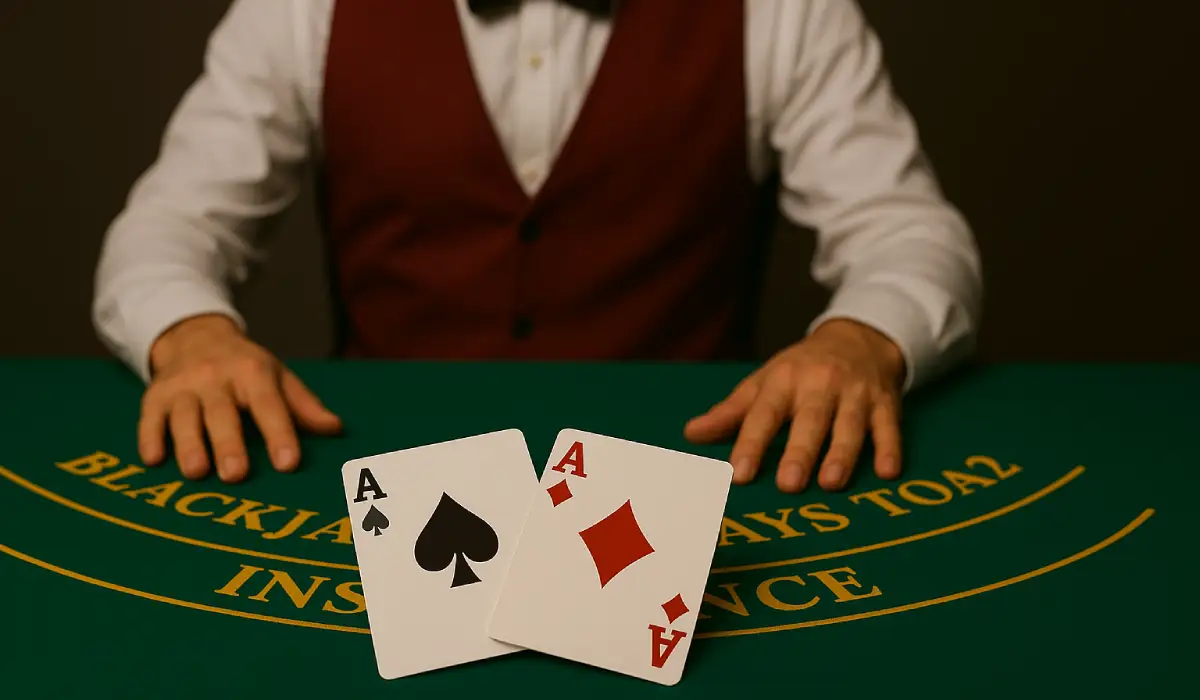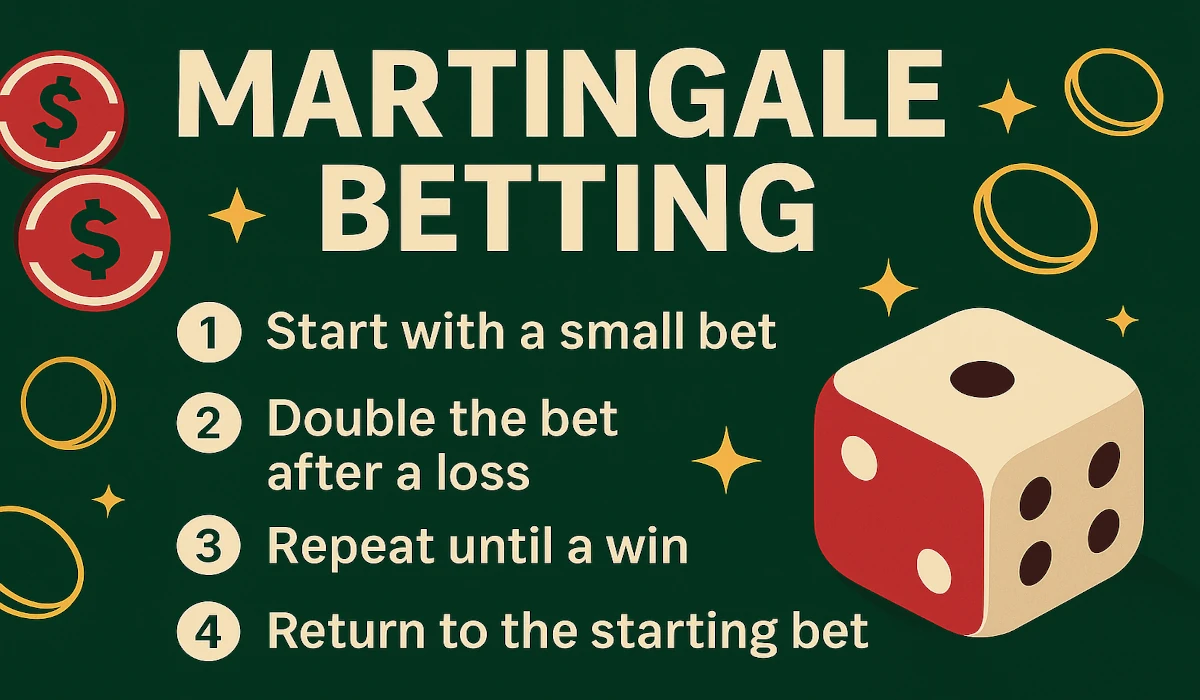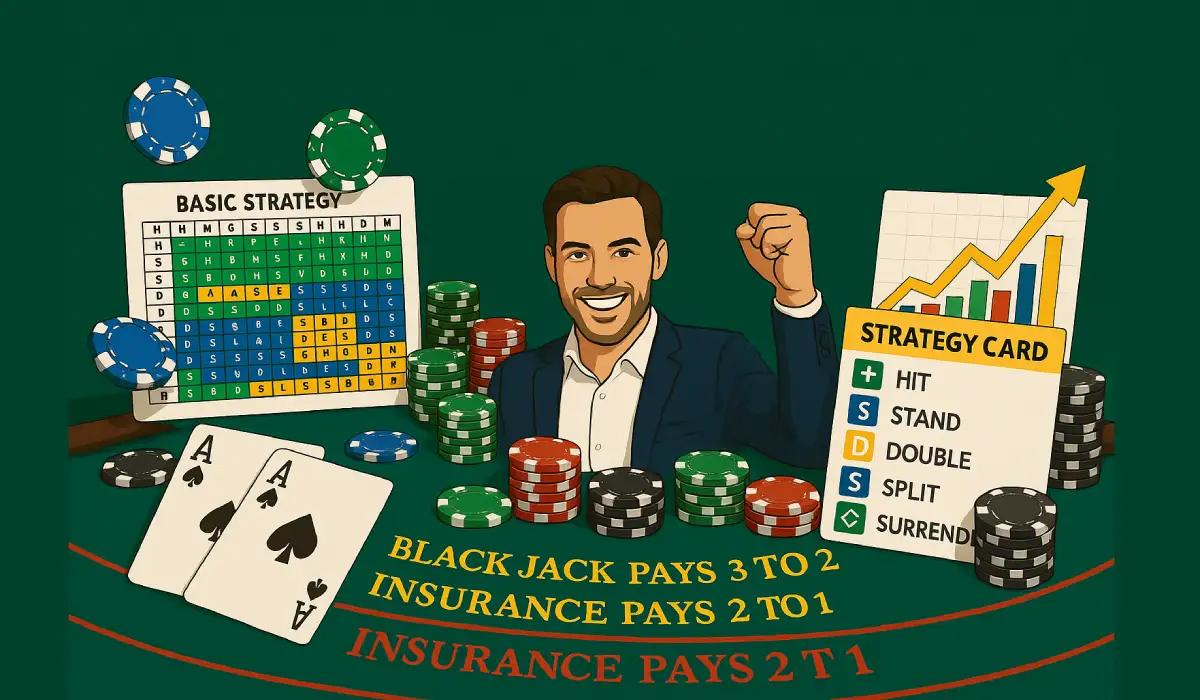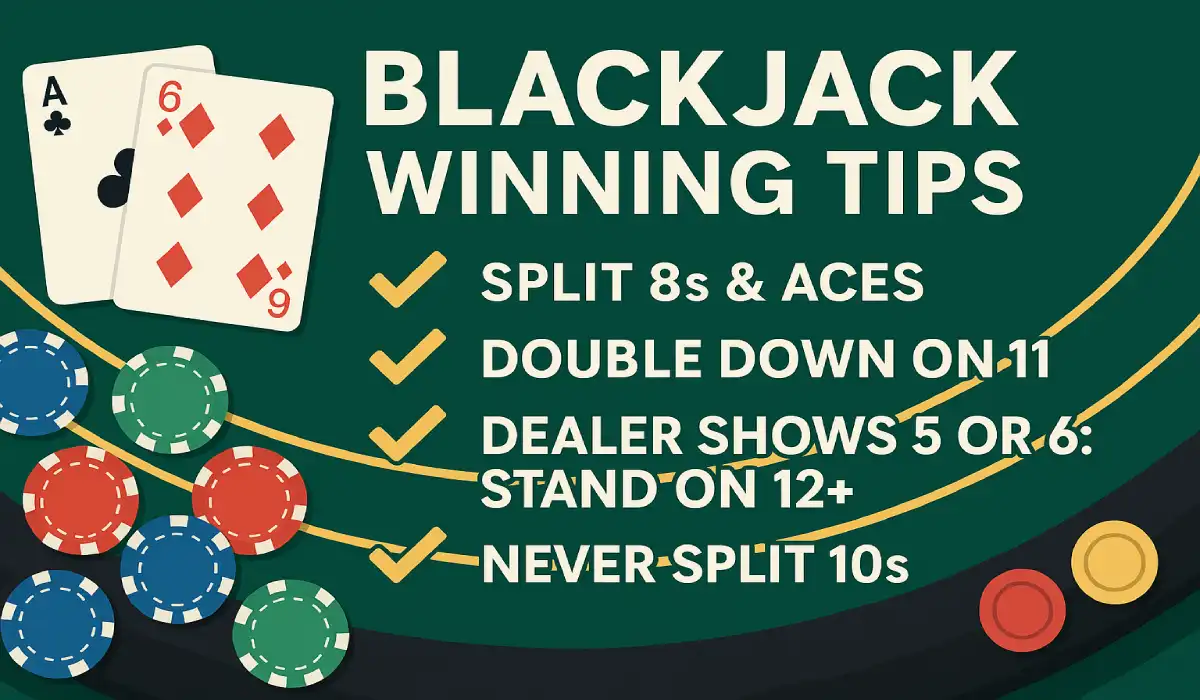
29 May 2025
When to Split Aces in Blackjack?
🗝️ Key Takeaways
- Splitting aces in blackjack goes back to the basics. It improves your odds of making premium hands and boosts your win rate in nearly every situation.
- Never, ever forget always to split aces! This strategy is universally optimal regardless of the dealer upcard because probability and expected value calculations always yield favorable results over the long run with this strategy in multiple blackjack variations.
- When splitting, players have to make an extra bet that matches their initial bet. This requirement means controlling your bankroll, and knowing how it will affect your general betting strategy is crucial.
- Know the rules of the casino you're in. Know the rules, including that you can't hit after splitting aces, and you can't re-split or double down in most places to save your bankroll from expensive errors.
- Don't fall into these common traps! Avoid the temptation to second guess the dealer's hand, undervalue your split aces, or forget to ask about table-specific rules before you sit down to play.
- More experienced players can further perfect their ace-splitting strategies by incorporating card counting. Knowledge of the different variations in rules is the best way to maximize your edge!
In blackjack, the ability to split aces allows you to turn a pair of aces into two separate hands immediately after the initial deal. Then, you'll get a new card for each hand, so you'll have the potential to increase your total points!
The primary reason why most casinos render this move a rare option is that it can significantly shift the odds in the player's favor. Remember that after you split, each ace gets only one additional card. Most house rules prohibit additional splits or hits on split aces.
This is one of the most important rules ever! Two aces combined only equal twelve points, but split aces provide two opportunities to reach twenty-one. Understanding the ins and outs of splitting aces can allow players to take a more strategic approach and better their odds.
The subsequent section goes into detail about the rules and etiquette surrounding this powerful move.
🎲 What Does "Split" Mean?
In blackjack, the term "split" means to separate a two-card starting hand of equal rank into two hands. This move gives you two playable hands.
When you split, you are required to make an additional bet that is equal to the amount of your initial bet. This rule allows you to double your action by playing two separate hands simultaneously, increasing the number of winning possibilities or risk mitigation strategies.
A total of two 8s, two 6s, or two Aces. Nearly all casinos allow you to split pairs. The underlying principle is to provide players with greater agency over their hands and more opportunities to win against the dealer.
✂️ Splitting: The Basic Idea
When you split, you take one hand and make it two. You make a second bet, and each subsequent round will receive an additional card from the deck.
To illustrate, split two 8s to begin with! You can split them and play them each with their own hand. This step provides you with an opportunity for much greater returns if you position yourself wisely.
Do what we all hear is the best advice! Never leave an ace or an 8 standing to minimize your losses and shift the odds in your direction. Splitting allows you to mitigate risk, meaning you don't have to bet all your chips on one bad-bust hand.
✨ Transforming Your Hand
Splitting Aces is one of the most powerful moves in blackjack. Instead of a terrible opening hand, you now have a great opening hand, two of them starting each with an Ace.
Your reward is an additional card per Ace. That gives you two chances at 21, which is the best possible hand to have! When the dealer's upcard is weak, split Aces may lead to substantial wins.
Splitting is one of the key ways to maximize your value on every hand, particularly when it comes to bad dealer upcards.
💰 The Second Bet Rule
Each time you split, you need to wager an amount equal to your initial bet. The Second Bet Rule requires you to monitor your bankroll.
Doubling your bet with a split can result in massive payouts, but it increases the danger. Understanding this Second Bet Rule allows you to wager strategically and prevent yourself from losing all your chips too early.
⚡ Why Aces Demand a Split
None of the moves you can make in blackjack is as incomparable as splitting aces. This is because of the ace's special value—1 point or 11 points. If you're dealt a pair of aces to open the game—you've got a terrible hand. Collectively, those aces make a soft dozen.
By choosing to split, a player can make this into two powerful hands. The rules would prevent each split ace from receiving more than one additional card, but the advantages are still applicable.
This core concept lies at the heart of the game's best strategies. The decision to split is not conditional on the dealer's up-card.
The math, the risk, and the real-world results all point in one direction: always split aces.
💪 Turning Weakness to Strength
Holding both aces requires playing a weak 12, which loses most of the time. By splitting, aces transform one undesirable hand into two fresh opportunities. Each ace now takes the lead on its own hand, with the next card drawn from the deck for each.
This change increases the player's agency and allows players two attempts at an excellent score, such as 21 or 20. The action upends the table, as both player and dealer instinctively sense the change in odds.
Two split aces can even result in two blackjacks, doubling both the risk and the reward for the player.
🏆 Two Chances for a Winner
Splitting aces provides two opportunities to get to a winning score. If the first hand doesn't win, there's still a chance to hit 21 with the second. The more aces you get, the more options you have to draw cards that build the best possible total.
That's a big deal, as even this small change translates into better odds of drawing at least one high-value hand. The payout increases if both separate hands win—at the highest payout of the two hands receiving blackjacks.
📊 The Math Behind the Move
Mathematically, the ace split makes sense. The expected value, or average payout in the long run, skyrockets when aces are split. Your chances of hitting 21 go up, too!
Even simply increasing the number of cards per ace to one increases your likelihood of getting a high total. In almost every game rule, splitting is the advantageous play, and the house edge can fall to as low as 0.40%.
By the numbers, this would be the best overall play for any player receiving two aces—whether at a land-based or online casino.
🃏 Your Ace Splitting Game Plan
Splitting aces in blackjack isn't just a textbook play. It's the most powerful strategy. This simple, pragmatic move dramatically increases your likelihood of success and puts you in the driver's seat of the game.
Aces are special in blackjack. Their versatility can take you deep or leave you busted, so learning how to play them properly is key.
These are the most important tactics to ensure you get as much as you can when you split aces. These approaches are supported by mathematics and decades of blackjack expertise.
- Always split aces, no matter what the dealer shows.
- Be aware that once you split, you usually only receive one card per ace.
- Watch for house rules: some allow resplitting or doubling down after a split.
- Don't expect any special payout if your split ace hand totals 21.
- Consider the dealer's upcard, but believe the math—it's still more advantageous to split.
- Consider probability and expected value (EV) when making decisions.
- Practice in different game settings to master your strategy.
1. The "Always Split Aces" Command
This is an easy, no-brainer rule. Two aces as a pair are weak—an ace and an ace is a soft 12, or simply 2. When you split them, you receive two chances at creating a premium hand. This is the case in just about every blackjack variant, as your odds of hitting a 10-value card are favorable.
Those who learn to follow this command avoid confusing choices and achieve greater success in the long run.
2. Dealer's Card: A Factor?
Even when the dealer shows a ten or ace, splitting aces increases your chances of winning. Since you lose both bets when you split if the dealer gets blackjack, this is a risk you should be aware of.
The answer is still the same math—splitting is always better.
3. Facing a Dealer's Ten: Split!
Many players resist splitting aces when the dealer shows a ten. Real-world data indicates that this is a bad move. Even when the dealer is showing their strongest cards, splitting aces gives you two legitimate opportunities at strong hands.
By comparison, standing or hitting with a pair of aces is a poor move. Most shocking victories in history are the product of this ballsy move.
4. Grasping Expected Value (EV)
Expected value is how much of a win or loss you should expect from a move, on average, in the long run. When you split aces, your EV is greater than all other plays combined with that hand.
For instance, splitting aces against any dealer upcard is more profitable in the long run than hitting or standing. EV wins the argument—splitting is profitable in the long haul.
5. Using Probability to Your Advantage
Understanding your chances goes a long way. Remember that a deck has sixteen ten-value cards. So, after splitting an ace, your probability of pulling a ten is greatly improved!
The rules often allow you to resplit or double, further stacking the odds in your favor. Make this math work to your advantage, and play smarter.
🎰 Casino Rules on Splitting Aces
Splitting aces in blackjack brings a special set of rules that can turn the tide of a hand. These are the rules that casinos implement to influence the odds and maintain a level playing field. When players split aces, they create two new hands, each with its own stake.
The options permitted after the split can be different from casino to casino. Knowing the rules and playing smart is your best bet to winning big and making the most out of every hand.
♠️ The Single Card Draw Rule
Most casinos stick to a simple rule: after splitting aces, you only get one card per ace. You aren't allowed to hit a second time on these hands and are required to stand on whatever you draw. This rule can seriously hurt (or help!) your strategy.
So, for example, if you draw a 10 on one of your split aces, you have a total of 21! If you draw a lower card, such as a 7, your total becomes 18—now you have no opportunity to do better. It's a rule players should be aware of and modify their strategy accordingly at each table.
⚔️ Split Aces vs. Natural Blackjack
A 21 created from a split ace and a 10-card does not qualify as a "natural" blackjack. The return is reduced to 1:1, not the typical 3:2 rate.
This fine print rule alters the odds and payout expectations significantly.
Understanding it will save you surprises and allow you to approach your betting strategy smartly.
🔄 Can You Re-Split Aces?
While some casinos allow you to resplit aces if you draw another ace, most do not. Generally, always check the online blackjack rules and house policy before you play! Utilizing the basic blackjack strategy can provide you with additional opportunities to make a winning hand or even cut down your action.
💸 Doubling Down Post-Split
Casinos typically restrict players from doubling down once aces have been split. Only a small handful of casinos still permit it. This reduces your potential winnings and alters the proper strategy for betting on split aces.
Understanding this rule in advance can save you from a costly error.
🔍 Spotting Rule Differences
- One card per split ace is standard.
- Resplitting aces may be allowed or blocked.
- Doubling down after splitting aces is rare.
- 21 from split aces pays 1:1, not 3:2.
- Some tables may let you hit on split aces.
Understanding the basic blackjack strategy and rules will save you from making mistakes and allow you to play confidently at different casinos. Always inquire about house rules before you sit down to play.
❌ Ace Splitting Mistakes to Avoid
Splitting aces is one of the more straightforward actions in blackjack, but there are several common mistakes players make that can kill their odds. These mistakes are usually due to not understanding the odds, playing on emotion instead of logic, or a lack of information about the table.
Awareness of these pitfalls can allow players of color to avoid missteps and create opportunities for winning plays.
🤯 Overthinking the Dealer's Hand
Some players lose focus on the dealer’s upcard, particularly if it’s a strong card. It’s easy to want to change a proven approach when the dealer has a 10-value card or an ace showing. Adjusting because of that isn’t wise in the long term.
The math that works in favor of splitting aces holds true against all but one dealer card. Even when the dealer shows a 10, continuing to make an intelligent no-split decision yields a better long-term payout. If the actual count ever goes below -6, hitting would be the wiser choice.
Don’t overthink the dealer’s hand. It’s pretty evident that the dealer is the opponent in a game of blackjack.
🃏 The "Dealer Ten" Intimidation
When you see a dealer’s 10, it’s intimidating, but it’s fear that causes players to stray from strategy more often. The smartest thing to do is listen to the numbers.
Splitting aces can still get you to strong hands, even in the face of a dealer’s 10. In the majority of casino games, you only get one card on each split ace. Take that chance, not the bait from the insurance or the intimidation from the dealer!
🎯 Misjudging Your Soft Hand
A soft hand—an ace and another card—has untapped strength. Many players fail to remember that two fresh hands, including one with an ace, provide excellent odds.
This is particularly true when players don’t want to split 5s or 10s. Don’t underestimate this – you’ll miss big wins. Whatever the case, confidence in this play is critical, even though you are unable to double down post-split.
📝 Forgetting Table-Specific Rules
Forgetting table-specific rules can be detrimental. Table rules are relative. Some permit resplitting aces, which can help increase your odds if you’re paying attention.
Be sure to ask what the house rules are before you sit down to play. It’s an easy detail to miss, but a mistake like this can be costly.
⚔️ Splitting vs. Taking Insurance
Many players are lured into taking insurance when the dealer deals an ace. The math doesn’t add up most of the time.
In the majority of situations, splitting aces provides a higher opportunity for profit than taking insurance. Recognizing this difference is essential for smart decision-making during gameplay.
🚀 Beyond Basic Ace Splitting
Advanced players understand that ace splitting is one of the essential blackjack strategies. There’s depth beyond the basics that you need to learn. In most casinos, only one card can be drawn for each split ace, reducing the potential upside.
Splitting aces just got you two legitimate shots at hitting 21! You shouldn’t be happy with a soft 12 or hard 2.
The most effective method is through sophisticated tactics. Play house rules to your advantage and combine strategies such as card counting in order to squeeze out the most value!
♠️ Advanced Ace Splitting Strategies:
- Be sure to verify that resplitting aces is permitted, as the ability to make additional splits can increase the likelihood of winning.
- Double after a split if rules permit. Combined with the other changes, this adds a potential edge of up to 0.15%.
- In no-hole card games, avoid splitting against a dealer ace.
- Avoid splitting if the payout for blackjack after a split drops to 1:1.
- Develop on the fly, knowing the table conditions and following house rules and side bets.
🃏 Ace Splitting with Card Counting
Card counting helps to maximize the ace-splitting decision. By keeping track of high (10-value) and low cards played, we can better estimate the probability of drawing a strong follow-up.
If lots of high cards are left, the ace splits aggressively. Accommodating card counting provides a much clearer advantage, particularly in games that allow doubles or resplits.
♦️ How Other Pairs Compare
Splitting aces is always better than standing on a soft 12. Other pairs, such as 8s (total 16), need to split because 16 is bad.
Pairs of 10s, however, should remain together, as 20 is the best hand. Alter splits according to the dealer’s exposed card (ex. Split 7s if the dealer is showing a lousy card).
❌ When Not to Split Other Pairs
Pairs such as 5s (total 10) or 10s (total 20) are examples of when not to split. Holding on to them provides greater chances.
Players benefit from memorizing these exceptions to ace-splitting for crisper, more competitive play.
⚙️ Advanced Rule Set Impacts
As rules vary from casino to casino, some rulesets permit resplitting or redistributing after splits, while others severely limit these advanced moves.
Adapting to each advanced rule set is critical for getting the best outcomes.
🎲 Side Bets and Splitting Decisions
Side bets not only increase risk but also enhance potential payouts. They can distract from strong traditional plays, so weigh their value against the basic blackjack strategy, especially regarding the blackjack split rule.
🔒 Conclusion
The ability to split aces is regarded as one of the most advantageous plays in blackjack. With rules that encourage you to play quickly, identifying the right time to split allows you to save chips and win the hand more often.
Most casinos will permit you to split once, after which you will hit one card on each ace. Some locations provide extra latitude, so always read the table rules.
Don't make even larger errors, such as standing and hitting twice after the split. Follow through on your strategy and be careful of house rules that can reduce your advantage.
To develop true skill, play with a group of friends, or practice using apps that allow you to test out your decisions.
If you want more tips or have any questions, leave a comment below or visit our Blackjack guide. Until next time, may luck be on the side of intelligent play.
Frequently Asked Questions❓
What does splitting aces in blackjack mean?
Splitting aces in blackjack, a key rule in many blackjack variants, refers to the practice of splitting a pair of aces into two individual hands. You put out a second bet equal to your first bet. With each ace, you get one more card—now you have two opportunities to create a strong hand!
Why should I always split aces in blackjack?
Always splitting aces in blackjack enhances your chances of hitting a strong hand, as each new ace offers a good opportunity to maximize your potential win, aligning with basic blackjack strategy for optimal outcomes.
Can I split aces more than once in a game?
Due to the blackjack split rule, most casinos won't let you split aces more than once. After the split, you typically receive only one additional card on each ace, so always verify the online blackjack rules at your individual table.
What happens if I get another ace after splitting?
If, after splitting, your draw into another ace, most casinos won't let you split again, affecting your basic blackjack strategy. You'll be actively playing the new ace as one of your separate hands, typically with only one new card added.
Are there any risks to splitting aces?
The biggest danger here is if the casino only allows you one card per ace, which can affect your basic blackjack strategy. This reduces your opportunities for a blackjack, but splitting is still almost always the ideal move.
Should I ever avoid splitting aces?
No, never avoid splitting aces. This is an unsophisticated, anti-blackjack basic strategy that every blackjack player will cheerfully have you avoid, as it provides the best chance to win in various blackjack variants.
Does splitting aces affect the house edge?
To answer the initial question—does the blackjack split rule change the house edge? This strategy increases your odds of drawing a winning hand, which is why it's regarded as one of the most important blackjack strategies!







